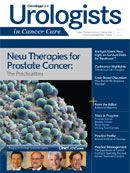A Word of Welcome
It is with great pleasure that I welcome you to the inaugural issue of Urologists in Cancer Care.
Raoul Concepcion, MD
Editor-in-Chief of
Urologists in Cancer Care
Director of Clinical Research Urologic Surgeon Urology Associates, PC Nashville, TN
It is with great pleasure that I welcome you to the inaugural issue of Urologists in Cancer Care. As all of us are so keenly aware, the beauty of our field is the diversity of patients who walk through our doors on any given day with a vast array of symptoms and disease states that we need to manage or diagnose. Whether our patients are male or female, adult or pediatric, symptom- or lab-driven or confirmed diagnosis, surgical or medical, we represent a true hybrid specialty that relies upon our cognitive and technical skills to adequately manage our patient population.
With the exponential growth in research and technology, it becomes very difficult for the average urologist to keep current with all the new advances in the field. In years past, reviewing a handful of lab data and x-rays and possessing superior history/physical exam skills were all that were required to provide the limited treatment options that were available for our patients. That is clearly not the case today. In order to adequately deliver state-of-the-art medicine for every patient, there are literally hundreds of pieces of data that we need to collate and evaluate. To make matters more complex, this has to be accomplished in a limited time frame, as physicians are being forced to see more patients in order to keep their practices financially viable.
It seems rather intuitive, then, that we—especially those who are in larger groups—encourage and promote an environment of subspecialization within practices, which in turn would foster the development of centers of excellence that optimize patient care. This model has been proven repeatedly in medicine (eg, Shouldice Hospital for hernia surgery) and in the business world (eg, Midas Mufflers). If you specialize in one thing and do it well, you become the recognized leader in providing these services, which should ideally result in higher patient satisfaction and superior clinical outcomes. Urologic oncology is an area that is perfectly suited for this type of specialization and represents an area of growing opportunity for urologists.
For the most part, urologists have been buoyed by the treatment success in many of the malignancies that we commonly see, particularly localized prostate cancer, nonmuscle-invasive transitional cell cancer of the bladder, and early-stage renal cell carcinoma. In the metastatic arena, we have become accustomed to, and perhaps jaded by, the near 100% cure rate for most testicular carcinomas. Over the past few years, there has been a burgeoning of therapies, primarily aimed at patients in the advanced metastatic state. This is particularly true for renal cell carcinoma and metastatic castration-resistant prostate cancer (mCRPC ). As many of you are aware, we have seen an explosion of oncolytic therapies that are FDA-approved for mCRPC, and I anticipate many more to come over the next 12 to 24 months.
What makes this particularly attractive for the urologist is the delivery of these agents. Some are administered orally, and others are injected subcutaneously or intravenously, with minimal side-effect profiles and are more efficacious than what previously had been available. These patients exist within our current practice—we have ushered them through diagnosis, definitive treatment, and are actively engaged in their follow-up. Most importantly, however, we now have therapies available that are superior and show documented survival benefits and better side-effect profiles that are better tolerated by the patient.
With the rapid advancements in this area, it makes sense to identify a “physician champion” in your group, one who is well-versed in the data and understands the regulatory limitations of these agents. This is a very dynamic field, and sequencing of these drugs is yet to be defined.
Although many challenges remain, the range of opportunities for urologists to expand our role in the treatment of patients with cancer is continually increasing. It is paramount for our specialty to become more active in identifying patients earlier in the course of disease and in helping to raise the quality of care for our patients. I am excited for this opportunity to be Editor-in-Chief of this new publication that will provide clinical updates and practical tools targeted specifically to urologists who treat patients with cancer. I hope that you will enjoy this first issue of Urologists in Cancer Care, and certainly invite you to contact me with any comments or suggestions for future coverage.
Finally, I dedicate this work to my father, a retired urologist and the first resident in urology at the Lahey Clinic, and to my late mother, who was perhaps my biggest fan. I am forever indebted.




